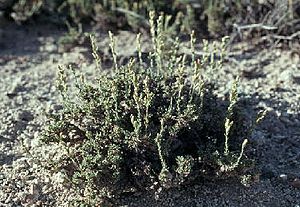Pygmy sagebrush facts for kids
Quick facts for kids Pygmy sagebrush |
|
|---|---|
 |
|
| Conservation status | |
| Scientific classification | |
| Genus: |
Artemisia
|
| Species: |
pygmaea
|
| Synonyms | |
|
|
Artemisia pygmaea, also called pygmy sagebrush, is a small plant found in North America. It belongs to the aster family, which includes many well-known flowers like sunflowers. This plant is a type of sagebrush.
Where Does Pygmy Sagebrush Grow?
Pygmy sagebrush naturally grows in the Southwestern United States. You can find it in parts of Nevada, Utah, Colorado, Arizona, and New Mexico. It is not common everywhere, but in some places, there can be many of these plants.
This plant likes very dry places. It grows in desert grasslands and pinyon-juniper woodlands. It can also be found in playas, which are dry lakebeds, especially in the Great Basin and Uinta Basin.
Pygmy sagebrush prefers soils that have a lot of calcium carbonate. This includes soils like gypsum and alkali soils, which are often salty. It can grow in clay soils too. This plant is special because it can live in places where most other plants cannot grow. Its small size helps it survive in these dry conditions.
What Does Pygmy Sagebrush Look Like?
Pygmy sagebrush is a small, cushion-shaped shrub. It usually grows up to about 20 centimeters (8 inches) tall. It has a woody stem and a deep taproot that helps it find water.
The leaves of this plant are very small, less than a centimeter long and wide. They often have jagged edges or are divided into several deep sections.
The plant's flower heads are also small. Each flower head has about 3 to 5 tiny disc flowers. Unlike some other plants in the aster family, it does not have ray flowers, which are the petal-like parts you see on a daisy.
Pygmy sagebrush is a dioecious plant. This means that male flowers and female flowers grow on separate individual plants. The plants usually bloom in August and September.
Interestingly, pygmy sagebrush can be a host for another plant called Orobanche fasciculata. This is a parasitic plant, which means it gets its food and water from the pygmy sagebrush instead of making its own.


